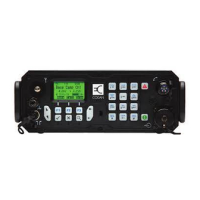HF radio transmission
Manpack Transceiver 2110 series Reference Manual 15
Frequency, distance and time of day
The extent to which an HF radio wave is reflected depends on the frequency that is used.
If the frequency is too low, the signal is absorbed by the ionosphere. If the frequency is
too high, the signal passes straight through the ionosphere. Within the HF band, low
frequencies are generally considered to be in the range of 2 to 10 MHz. High frequencies
are above 10 MHz.
A frequency chosen for daytime transmission may not necessarily be suitable for night-
time use. During the day, the layers of the ionosphere are thick. The layers absorb lower
frequencies and reflect higher frequencies. At night, the ionosphere becomes very thin.
The low frequencies that were absorbed during the day are reflected, and the high
frequencies that were reflected during the day pass straight through.
Summer HF radio communications usually operate on higher frequencies than those
used in winter over the same distance.
Solar activity varies over an 11 year cycle. Higher frequencies need to be used during
periods of peak activity.
It is important to remember that you may need to change the frequency you are using to
achieve the best communication. The general rules of thumb for HF radio
communication are:
• the higher the sun, the higher the frequency
• the further the distance, the higher the frequency
Channels and modes
A channel is a name that is given to a frequency or a pair of frequencies, for example,
‘Channel 1’, ‘4500’ and ‘Headquarters’. The frequencies may be any frequencies within
the HF range.
Each channel has one or more modes associated with it. Each mode indicates a sideband
that can be used with the channel, such as USB or LSB. When you make a call you must
specify the channel and the mode you want to use.
Table 1: Examples of channels and modes
Channel Receive frequency
(kHz)
Transmit frequency
(kHz)
Modes
Channel 1 10600 10600 LSB, USB
4500 4500 – AM
Headquarters 22758 23000 USB

